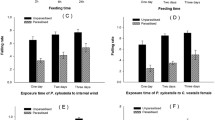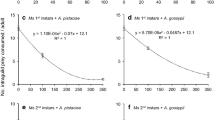Abstract
Competitive interactions in arthropod predators are well-known, but positive interactions have received less attention. The two-spotted stinkbugPerillus bioculatus often feeds gregariously on leaf beetle larvae and caterpillar prey. Consequences of prey sharing amongP. bioculatus conspecifics of dissimilar size (instar) was studied using Colorado potato beetle (CPB) prey. Rearing second-instar (N2) nymphs ofP. bioculatus with an N5 conspecific facilitated early feeding on L4 CPB larvae (a difficult prey to handle by N2 nymphs but not by N5’s), thus increasing survival and accelerating development. One in every 20 cases ofP. bioculatus foraging in the field was accounted for by pairs or small groups of mostly feeding individuals. CPB egg masses and L4’s represented a disproportionate number of cases of aggregated feeding byP. bioculatus, compared to feeding singly. Small CPB larvae decreased in the diet of aggregated stinkbugs compared to L4 larvae and egg masses, suggesting that sharing these prey may be favorable or unavoidable. In a field test measuring residence/survival of N2’s limited to L4 prey, the N2’s rate of residence/survival increased significantly when large nymphs acting as food providers were also present. The function of communal feeding inP. bioculatus is discussed, as well as the potential for greater impact on prey density that may be expected from tolerance to opportunistic feeding by conspecifics in slightly gregarious predators.
Similar content being viewed by others
References
Agresti, A. (1990).Categorical Data Analysis, Wiley, New York.
Aldrich, J. R. (1988). Chemical ecology of the Heteroptera.Annu. Rev. Entomol. 33: 211–238.
Aldrich, J. R., Oliver, J. E., Lusby, W. R., and Kochansky, J. P. (1986). Identification of male-specific exocrine secretions from predatory stink bugs (Hemiptera: Pentatomidae).Arch. Insect. Biochem. Physiol. 3: 1–12.
Bell, W. J. (1991).Searching Behaviour. The Behavioural Ecology of Finding Resources, Chapman & Hall, London.
Biever, K. D., and Chauvin, R. L. (1992a). Timing of infestation by the Colorado potato beetle (Coleoptera: Chrysomelidae) on the suppressive effect of field released stinkbugs (Hemiptera: Pentatomidae) in Washington.Environ. Entomol. 21: 1212–1219.
Biever, K. D., and Chauvin, R. L. (1992b). Suppression of the Colorado potato beetle (Coleoptera: Chrysomelidae) with augmentative releases of predaceous stinkbugs (Hemiptera: Pentatomidae).J. Econ. Entomol. 85: 720–726.
Cloutier, C., and Johnson, S. G. (1993). Interaction between life stages in a phytoseiid predator: Prey killed by adults as food for protonymphs ofAmblyseius cucumeris.Exp. Appl. Acarol. 17: 441–449.
Cloutier, C., and Bauduin, F. (1995). Biological control of the Colorado potato beetleLeptinotarsa decemlineata (Coleoptera: chrysomelidae) in Quebec by augmentative releases of the two spotted-stinkbugPerillus bioculatus (Hemiptera: Pentatomidae).Can. Entomol. 127: 195–212.
Curio, E. (1976).The Ethology of Predation, Springer-Verlag, Berlin.
Evans, E. W. (1982). Feeding specialization of predatory insects: Hunting and attack behavior of two stinkbugs species (Hemiptera: Pentatomidae).Am. Midl. Nat. 108: 96–104.
Evans, E. W. (1983). Niche relations of predatory stinkbugs (Podisus, spp., Pentatomidae) attacking tent caterpillars (Malacosoma americanum),Am. Midl. Nat. 109: 316–323.
Evans, E. W., and Root, R. B. (1980). Group molting and other lifeways of a solitary hunter,Apateticus bracteatus (Hemiptera: Pentatomidae).Ann. Entomol. Soc. Am. 73: 270–274.
Fagan, W. F., and Odell, G. M. (1996). Size-dependent cannibalism in praying maintids: Using bimass fus to model size-structured populations.Am. Nat. 147: 230–278.
Fleiss, J. L. (1981). Statistical methods for rates and proportions, 2nd ed., Wiley, New York.
Foelix, R. F. (1982).Biology of Spiders, Harvard University Press, Cambridge, MA. pp. 253–256.
Fox, L. R. (1975). Cannibalism in natural populations.Annu. Rev. Ecol. Syst. 6: 87–106.
Hare, J. D. (1990). Ecology and management of the Colorado potato beetle.Annu. Rev. Entomol. 35: 81–100.
Harvey, P. H., and Gittleman, J. L. (1992). Correlates of carnivory: Approaches and answers. In Crawley, M. J. (ed.),Natural enemies, Blackwell, London, pp. 26–39.
Hassell, M. P. (1978).Arthropod Predator-Prey Systems, Princeton University Press, Princeton, NJ.
Hassell, M. P., and Varley, G. C. (1969). New inductive population model for insect parasites and its effect on stability.Nature 223: 1133–1136.
Hodge, M. A., and Uetz, G. W. (1995). A comparison of agonistic behavior of colonial web-building spiders from desert and tropical habitats.Anim. Behav. 50: 963–972.
Hough-Goldstein, J. A., Heimpel, G. E., Bechman, H. E., and Mason, C. E. (1993). Arthropod natural enemies of the Colorado potato beetle.Crop Prot. 12: 324–334.
Jermy, T. (1980). The introduction ofPerillus bioculatus into Europe to control the Colorado Beetle.IOBC Bull. EPPO 10: 475–479.
Krafft, B. (1965) Sur une possibilité d’échanges de substance entre les individus chez l’araignée socialeAgelena consociata Denis.C.R. Acad. Sci. Paris 260: 5376–5378.
Lawless, J. F. (1982).Models and Methods for Lifetime Data, Wiley, New York.
Legaspi, J. C., and O’Neil, R. J. (1993). Life history ofPodisus maculiventris given low numbers ofEpilachna varivestis as prey.Environ. Entomol. 22: 1191–1200.
McPherson, J. E. (1982).The Pentatomidae (Hemiptera) of Northeastern North America with Emphasis on the Fauna of Illinois, Southern Illinois University Press, Carbondale and Edwardsville.
Milliken, G. A., and Johnson, D. E. (1994).Analysis of Messy Data. Vol. 1. Designed Experiments, Van Nostrand, Reinhold, New York.
Murdoch, W. W. (1966). Population stability and life history phenomena.Am. Nat. 100: 5–11.
New, T. R. (1991).Insects as Predators, New South Wales University, Kensington, Australia.
Oster, G. F., and Wilson, E. O. (1978).Caste and Ecology in the Social Insects, Princeton University, Princeton, NJ.
Sabelis, M. W. (1992) Predatory insects. In Crawley, M. J. (ed.),Natural Enemies: The Population Biology of Predators, Parasites and Diseases, Blackwell, London, pp. 225–264.
Saint-Cyr, J.-F., and Cloutier, C. (1996). Prey preference by the stinkbugPerillus bioculatus, a predator of the Colorado potato beetle.Biol. Contr. 7: 251–258.
SAS (1990).SAS/STAT User’s Guide. Version 6, 4th ed. SAS Institute, Cary, NC, pp. 1027–1069.
Schneider, J. M. (1996). Food intake, growth and relatedness in the subsocial spider,Stegodyphus lineatus (Eresidae).Ethology 5: 386–396.
Tallamy, D. W., and Wood, T. K. (1986). Convergent patterns in subsocial insects.Annu. Rev. Entomol. 31: 369–390.
Tamaki, G., and Butt, B. A. (1978). Impact ofPerillus bioculatus on the Colorado potato beetle and plant damage. USDA Science and Education Administration Technical Bulletin No. 1581.
Author information
Authors and Affiliations
Rights and permissions
About this article
Cite this article
Cloutier, C. Facilitated predation through interaction between life stages in the stinkbug predatorperillus bioculatus (Hemiptera: Pentatomidae). J Insect Behav 10, 581–598 (1997). https://doi.org/10.1007/BF02765379
Received:
Revised:
Issue Date:
DOI: https://doi.org/10.1007/BF02765379




